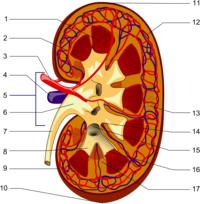
Photo from wikipedia
Renal artery aneurysm (RAA) is a rare disease. The incident rate detected upon autopsy was 0.3e0.7%. The incidence is almost 1% for the population undergoing renal artery angiography.1 In recent… Click to show full abstract
Renal artery aneurysm (RAA) is a rare disease. The incident rate detected upon autopsy was 0.3e0.7%. The incidence is almost 1% for the population undergoing renal artery angiography.1 In recent years, with increasing use of ultrasonography, computed tomography (CT), magnetic resonance imaging (MRI), and digital subtraction angiography (DSA) for renal artery, asymptomatic RAA has been widely recognised and treated.2 In the last century, RAAwas most commonly treated with surgical resection. Now, with the development of interventional microcatheterguidewire systems and new embolic materials, endovascular treatment has become the first-line therapy for RAA because of its minimal invasiveness and because it is associated with minor complications and low mortality.3 The aim of the present study was to describe the authors’ experience with RAA, focusing on the outcomes of different therapeutic modalities for RAA and to provide a scientific approach to the treatment for RAA.
Journal Title: Clinical radiology
Year Published: 2018
Link to full text (if available)
Share on Social Media: Sign Up to like & get
recommendations!